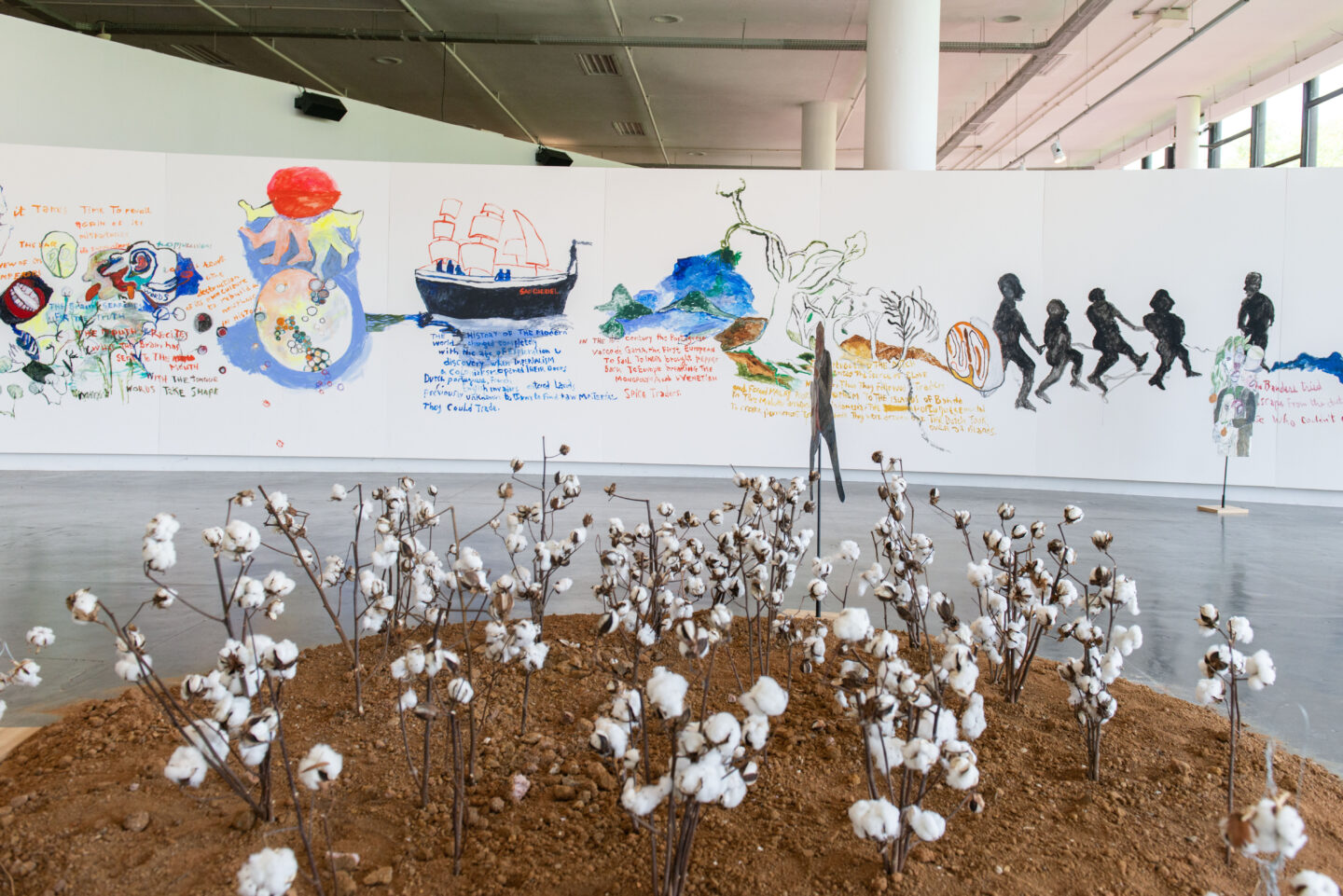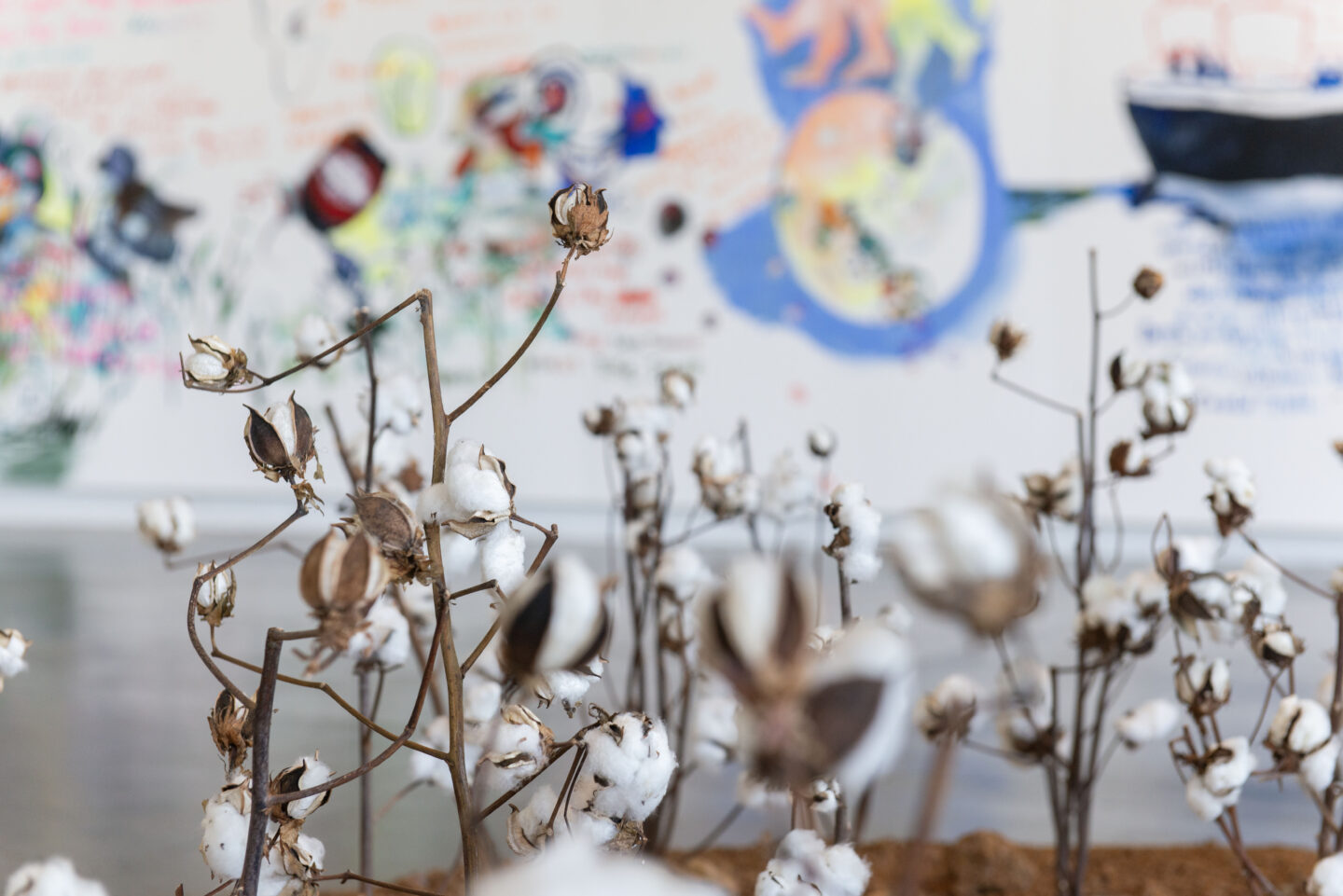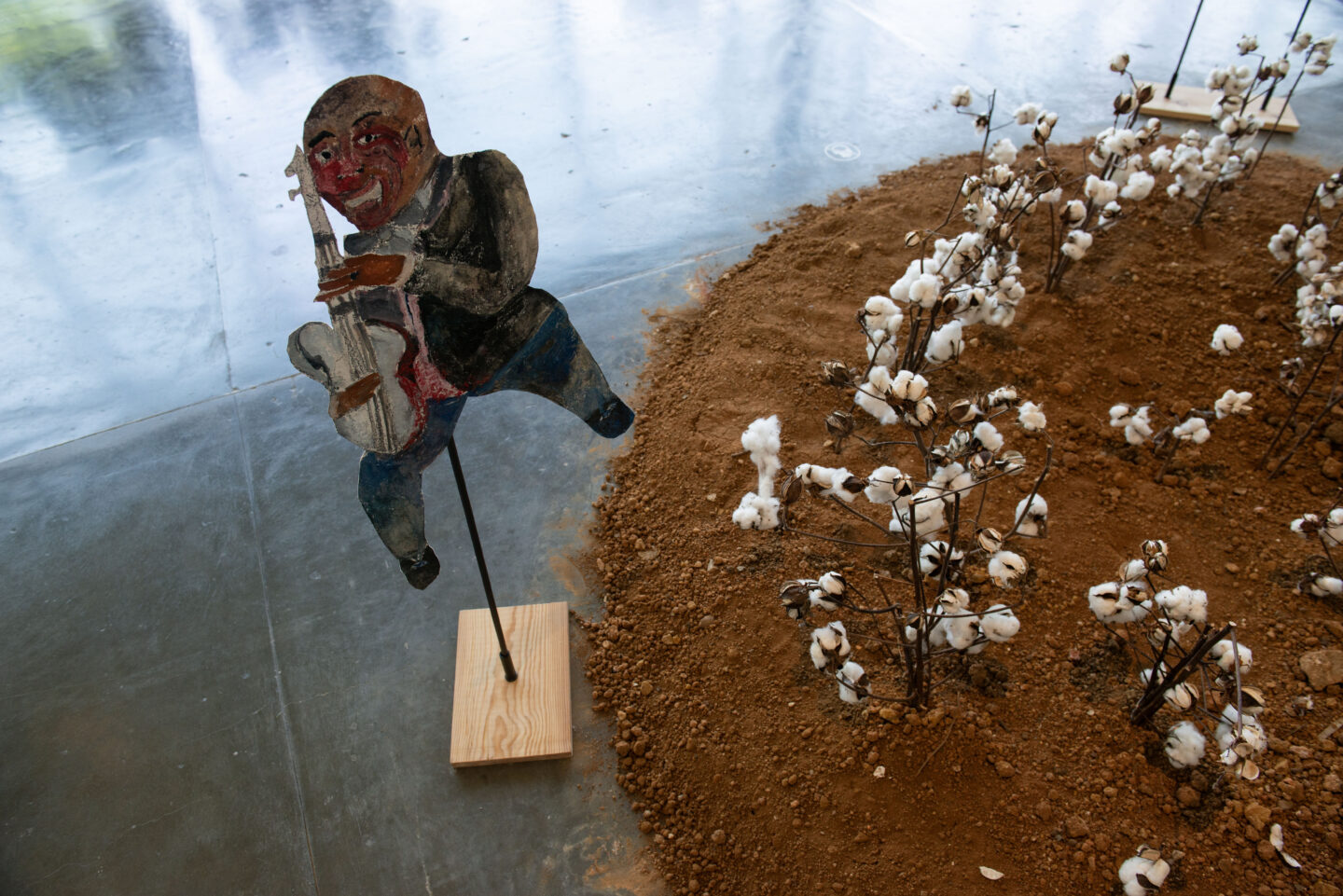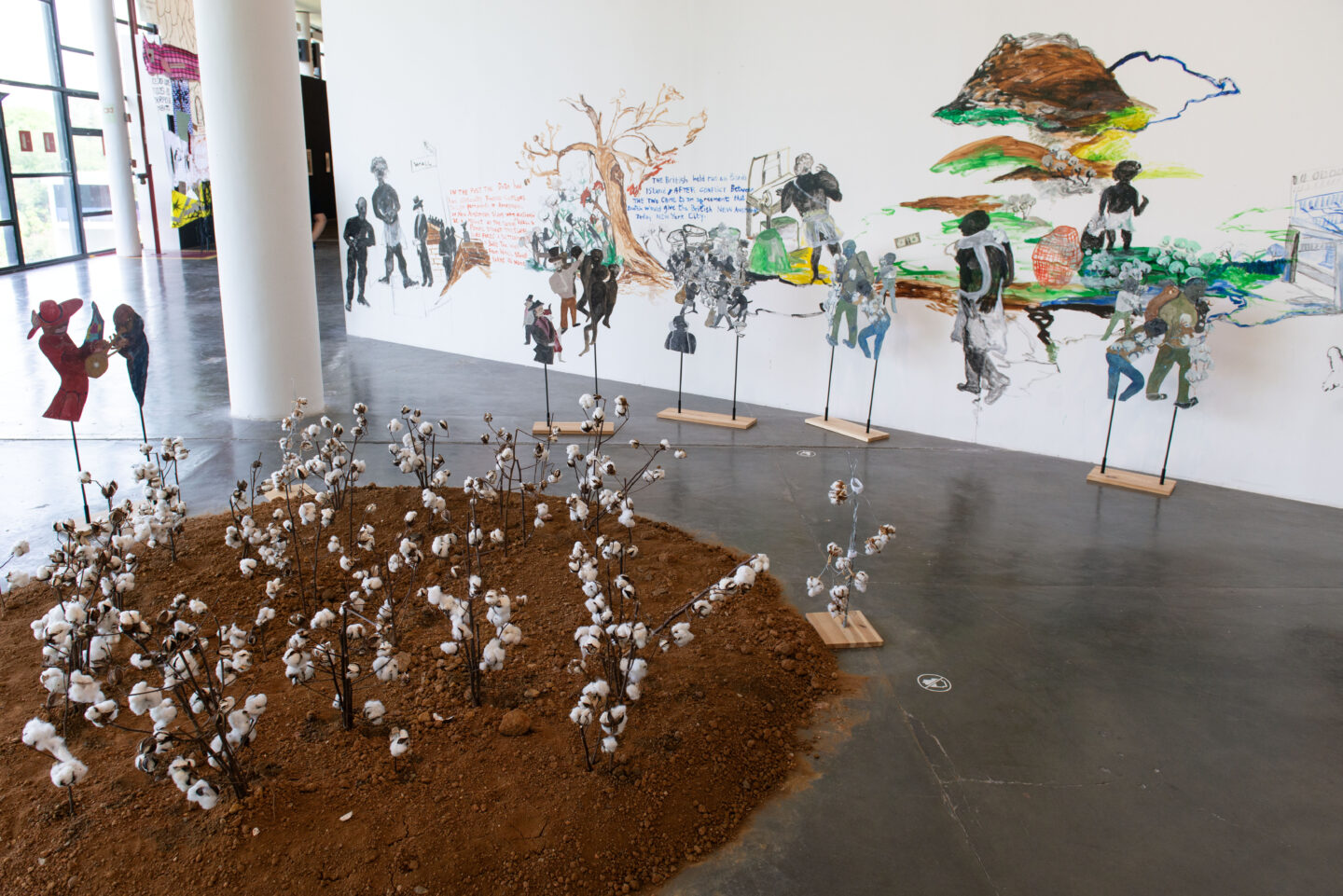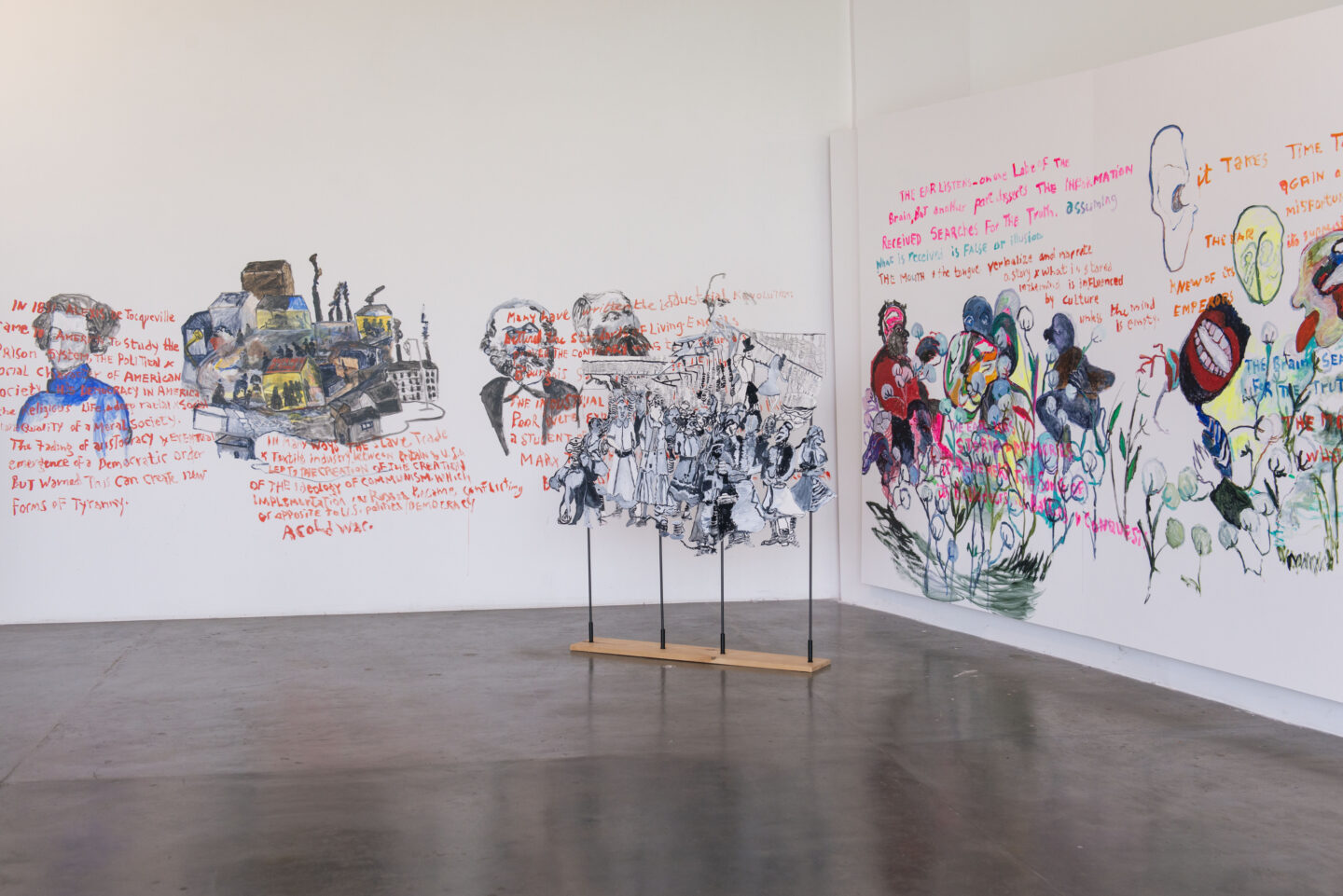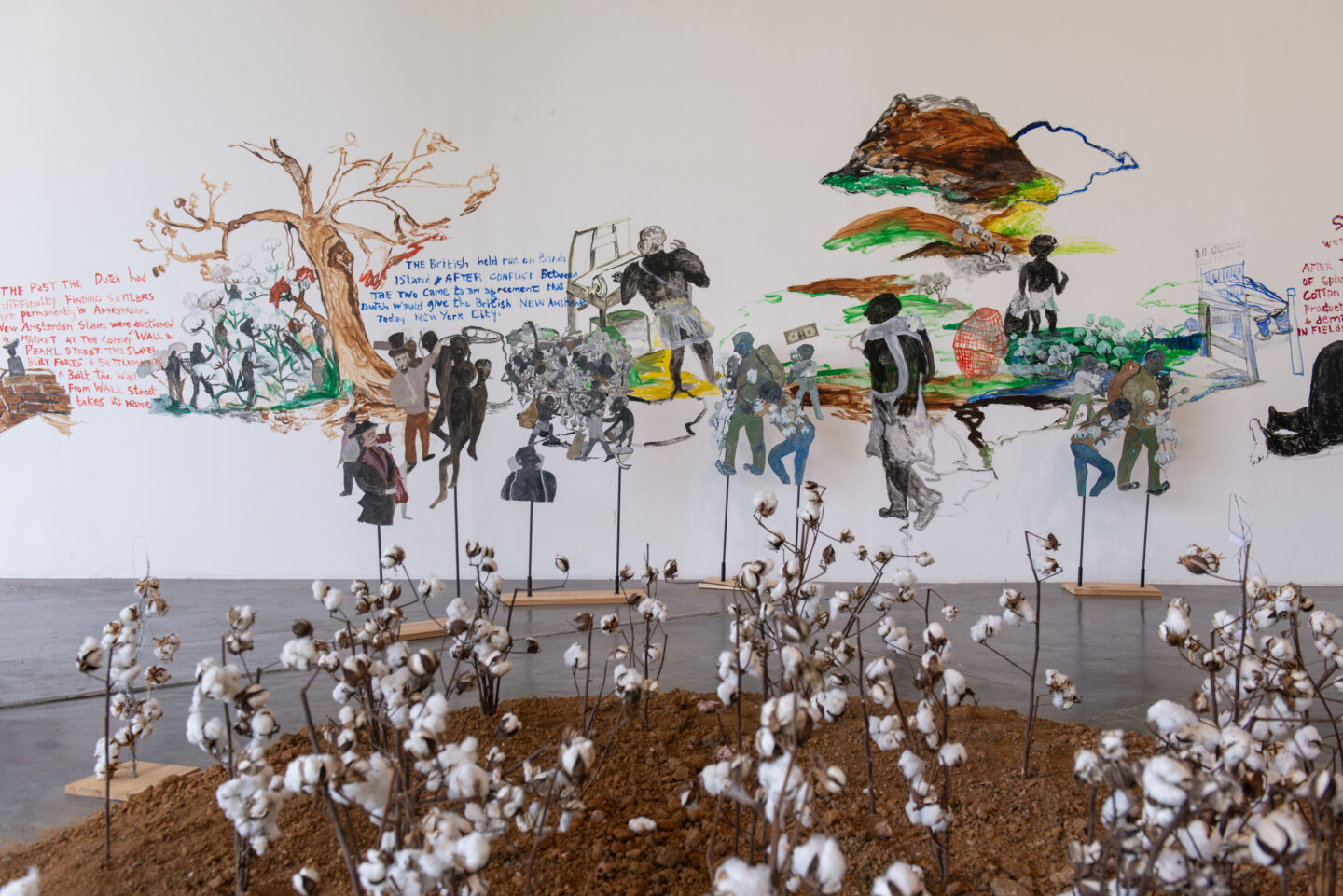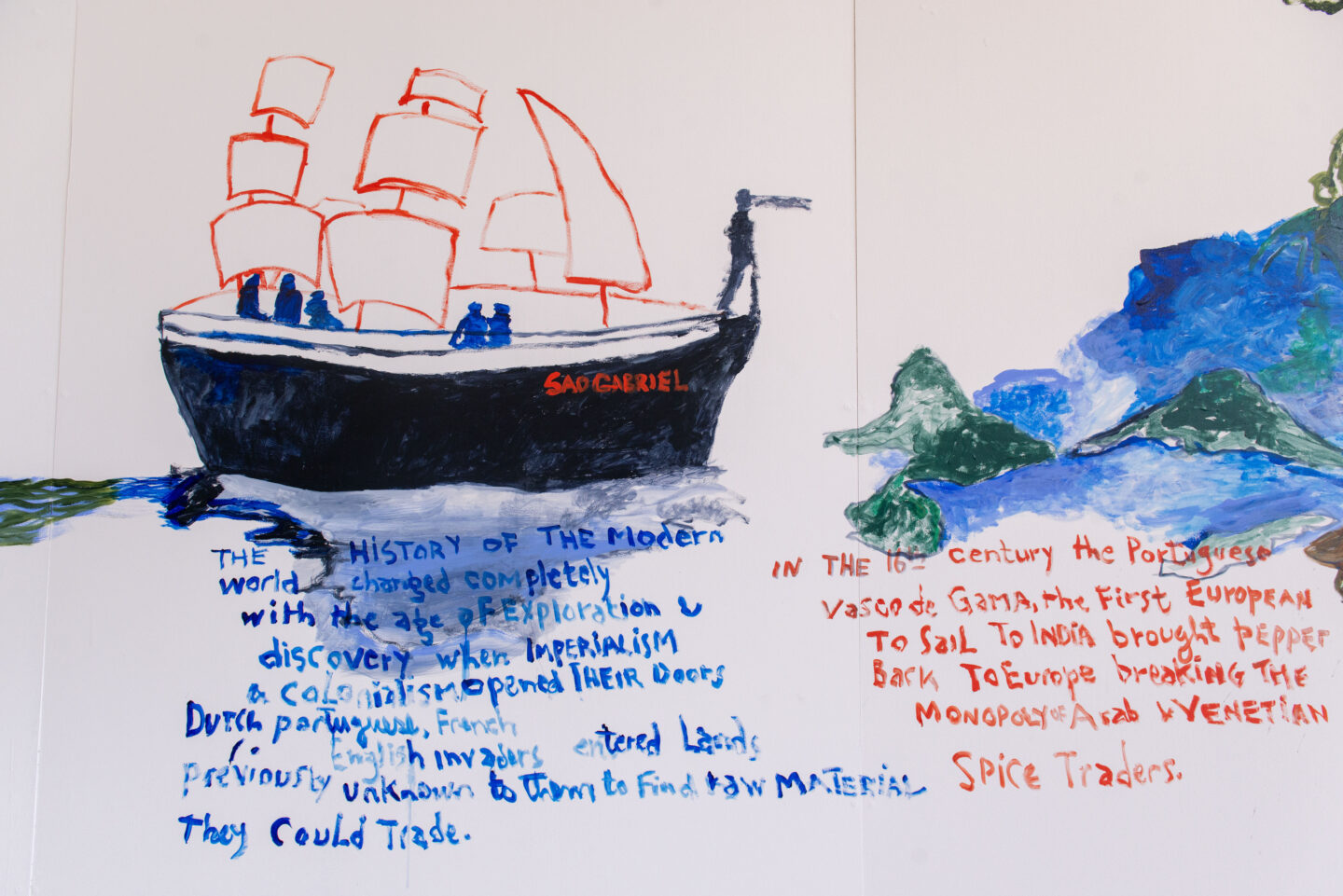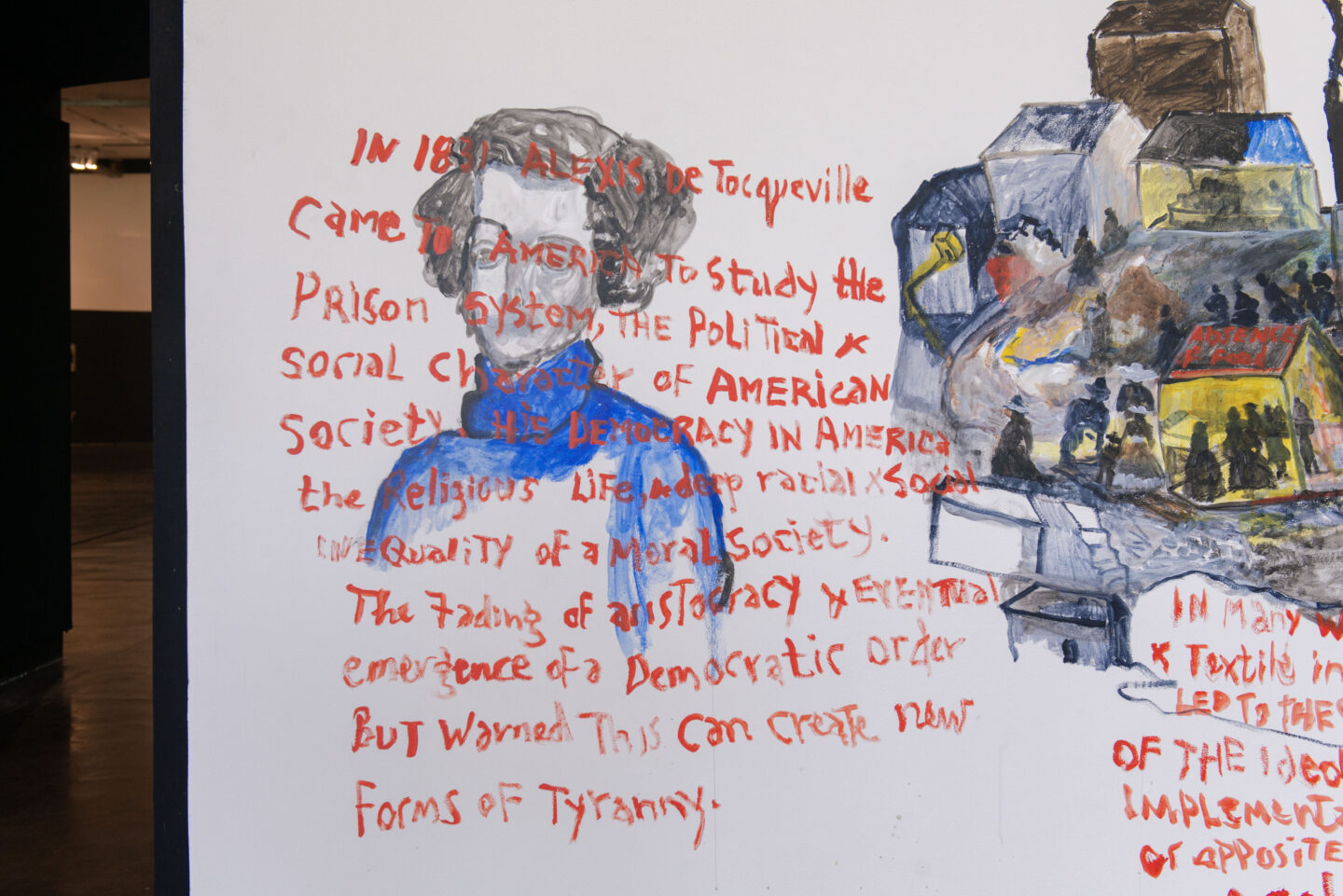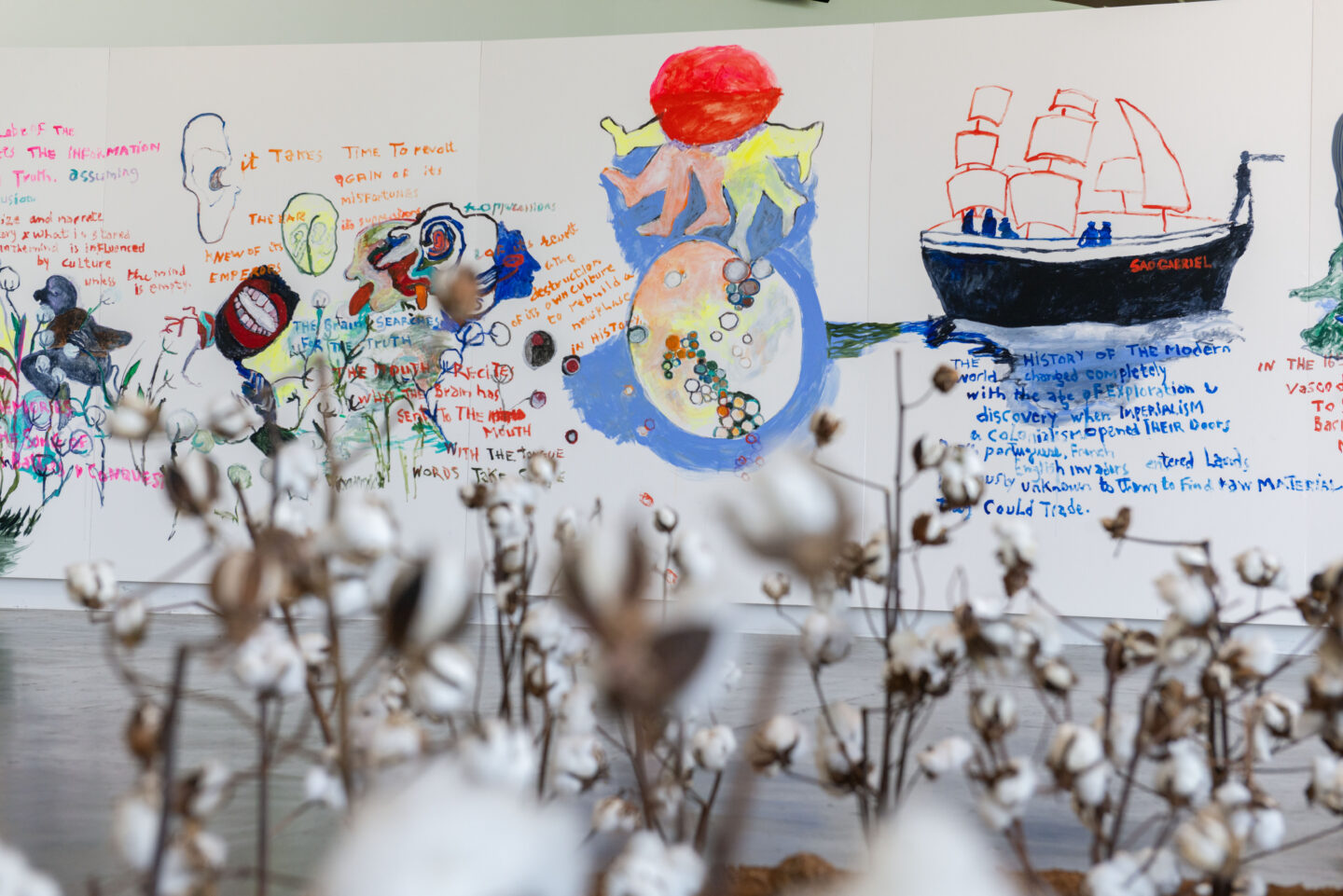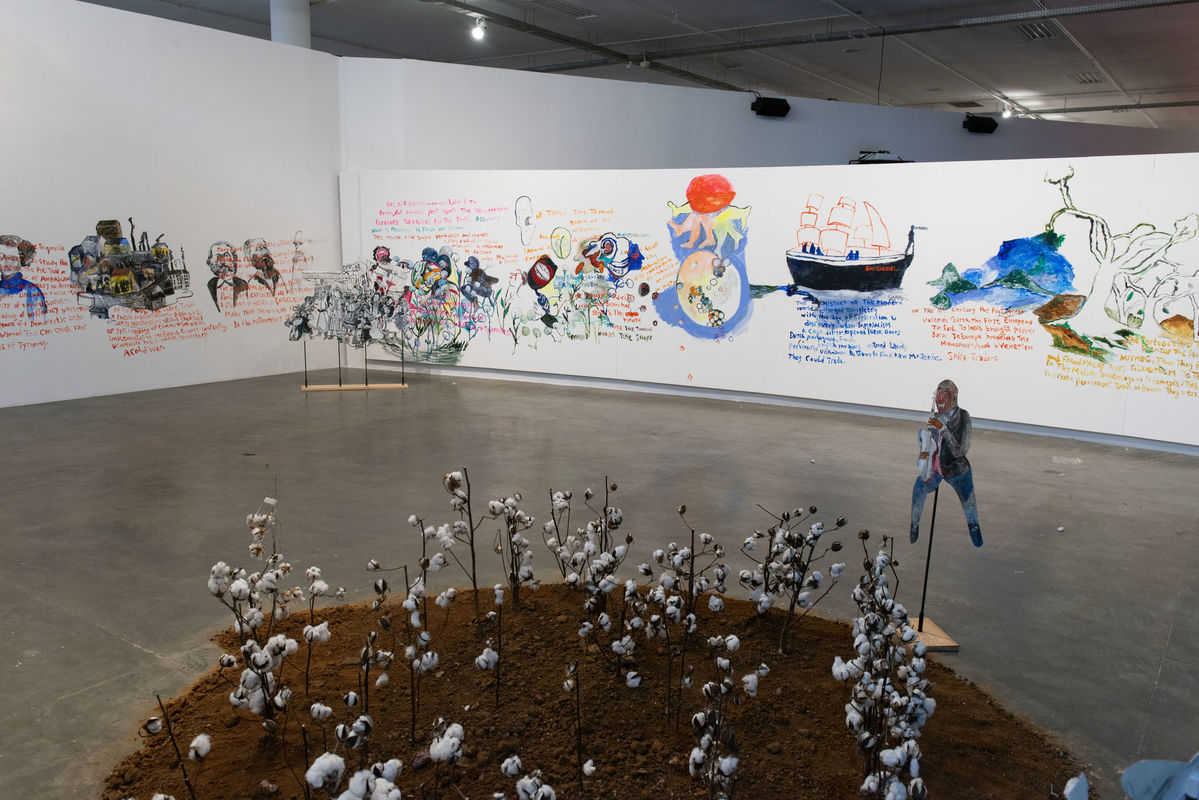
Anna Boghiguian
Anna Boghiguian’s work is a polyphonic narrative that unfolds through drawings, paintings, dioramas, installations, and texts. It is, at the same time, an astonishing tool of historical investigation that, without yielding anything in terms of poetics, is able to analyze specific contexts, fragments of individual lives, and wide-ranging phenomena. The latter is the case in Woven Winds – The Making of an Economy – Costly Commodities (2016–-22), in which, through drawings, texts, collages, and self-supporting cutouts, the artist recounts the genesis and development of the cotton trade, an activity that both anticipates and prophesizes the contemporary globalization of the economy.
Malcolm Ferdinand, a scholar of political ecology, prefers to refer to our era with the term Plantationocene (the age of the plantation) to emphasize the responsibilities of colonialism in the current social and ecological crisis. Boghiguian’s work seems to corroborate this thesis. Indeed, before her work, the viewer is immersed in a story populated by enslaved West Africans deported to the New World to work on cotton (and other) plantations, those same plantations that replaced Indigenous forms of cultivation and circulation of products to make way for an extractive, profit-driven production model.
The dramatic stories of the enslaved are intertwined with those of European migrants. In fact, Boghiguian depicts a ship in the act of unloading its cargo of poor Europeans (such as the Irish forced to flee the Great Famine of 1845, which lasted until 1849) landed in the United States to contribute to the formation of the great wealth of that nation that, as the artist points out, owes much to the cultivation of cotton and the fact that it was organized on the basis of chattel slavery.
A tireless traveler, Boghiguian trained between Egypt, Canada, and Mexico. Her art is a form of recording reality and context, but never with a detached gaze. On the contrary, this artist’s work is always positioned with respect to the social conditions of the present and often includes an interrogation of the historical events that produced them. At the same time, the artist’s great love for Symbolist painting – Gustave Moreau and William Blake, for example – emerges through a surreal vein that is an integral part of her poetics, deconstructing the official languages of power, desecrating their “sacred” representations: a hallucinated and ironic dream in which the artist moves her own poetic attack on absolute power and its incarnations.
marco baravalle
- Vista da obra Woven Winds – The Making of an Economy – Costly Commodities [Ventos entrelaçados – A formação de uma economia – Commodities custosas] de Anna Boghiguian durante a 35ª Bienal de São Paulo – coreografias do impossível © Levi Fanan / Fundação Bienal de São Paulo
- Detalhe da obra Woven Winds – The Making of an Economy – Costly Commodities [Ventos entrelaçados – A formação de uma economia – Commodities custosas] de Anna Boghiguian durante a 35ª Bienal de São Paulo – coreografias do impossível © Levi Fanan / Fundação Bienal de São Paulo
- Detalhe da obra Woven Winds – The Making of an Economy – Costly Commodities [Ventos entrelaçados – A formação de uma economia – Commodities custosas] de Anna Boghiguian durante a 35ª Bienal de São Paulo – coreografias do impossível © Levi Fanan / Fundação Bienal de São Paulo
- Vista da obra Woven Winds – The Making of an Economy – Costly Commodities [Ventos entrelaçados – A formação de uma economia – Commodities custosas] de Anna Boghiguian durante a 35ª Bienal de São Paulo – coreografias do impossível © Levi Fanan / Fundação Bienal de São Paulo
- Vista da obra Woven Winds – The Making of an Economy – Costly Commodities [Ventos entrelaçados – A formação de uma economia – Commodities custosas] de Anna Boghiguian durante a 35ª Bienal de São Paulo – coreografias do impossível © Levi Fanan / Fundação Bienal de São Paulo
- Vista da obra Woven Winds – The Making of an Economy – Costly Commodities [Ventos entrelaçados – A formação de uma economia – Commodities custosas] de Anna Boghiguian durante a 35ª Bienal de São Paulo – coreografias do impossível © Levi Fanan / Fundação Bienal de São Paulo
- Detalhe da obra Woven Winds – The Making of an Economy – Costly Commodities [Ventos entrelaçados – A formação de uma economia – Commodities custosas] de Anna Boghiguian durante a 35ª Bienal de São Paulo – coreografias do impossível © Levi Fanan / Fundação Bienal de São Paulo
- Detalhe da obra Woven Winds – The Making of an Economy – Costly Commodities [Ventos entrelaçados – A formação de uma economia – Commodities custosas] de Anna Boghiguian durante a 35ª Bienal de São Paulo – coreografias do impossível © Levi Fanan / Fundação Bienal de São Paulo
- Detalhe da obra Woven Winds – The Making of an Economy – Costly Commodities [Ventos entrelaçados – A formação de uma economia – Commodities custosas] de Anna Boghiguian durante a 35ª Bienal de São Paulo – coreografias do impossível © Levi Fanan / Fundação Bienal de São Paulo
Anna Boghiguian (Cairo, Egypt, 1946. Lives in Cairo) draws inspiration from travel and studies of diverse art forms to create unique narratives through collage, books, drawings, paintings, and installations. Her works have been exhibited in various spaces, including the Museum der Moderne Salzburg (Austria), New Museum (New York, USA), 31st Bienal de São Paulo (Brazil), La Triennial di Milano (Italy), and Documenta 13 (Kassel, Germany). Her works are included in the collections of institutions such as MoMA (Nova York, USA) and Guggenheim (Abu Dhabi, United Arab Emirates).

 Português
Português